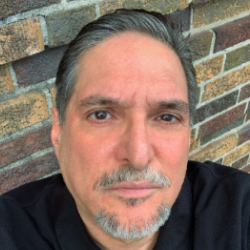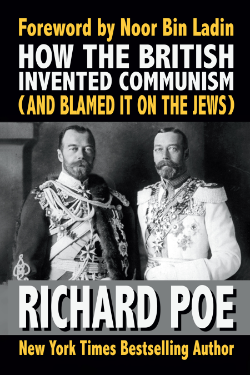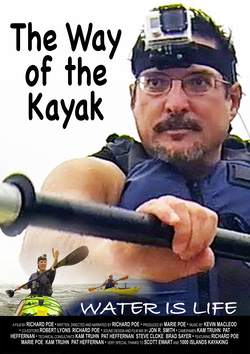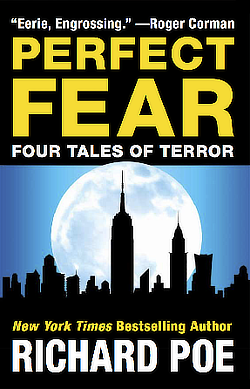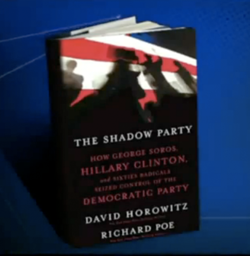PERFECT FEAR: AUTHOR INTERVIEW, PART 6
A Conversation with Richard Poe, Author of Perfect Fear
by Paul Germano (continued)
| « PREVIOUS PAGE | NEXT PAGE » |
LEARNING FROM HORROR FILMS
Germano: How about horror filmmakers? Who are your favorites?
Poe: My favorite horror films are the classics from the 1930s, ‘40s and ‘50s. In those days, you couldn’t rely on the shock value of graphic gore or digital effects, so filmmakers had to learn how to stimulate the imagination, using atmosphere, folklore, gripping stories and strong characters. I probably learned a lot more about the craft of horror from watching Monster Movie Matinee as a kid, than I did from reading books.
Germano: Ah yes, Monster Movie Matinee. That takes me back. I should explain to readers that Monster Movie Matinee was part of the local TV landscape in Syracuse. It aired old horror movies and had a benevolently evil host named Dr. E. Nick Witty and his Igor-type sidekick, named Epal. Dr. Witty and Epal lived in a low-budget version of Frankenstein’s castle, with a lot of dry-ice mist floating around. They would appear at the beginning of the show to introduce the movies, and they also had their own running storylines that continued from week to week. Monster Movie Matinee was my first real exposure to horror and introduced me to The Creature from the Black Lagoon, The Incredible Shrinking Man and a slew of other classic and not-so-classic horror films. So tell me, Richard, what kind of impact did Monster Movie Matinee have on your early-childhood development?
Poe: It was like a free course in horror film history. They showed all the classics from the glory days of Universal Studios, including Frankenstein, Dracula, The Mummy, The Wolf Man and so on. They had a limited number of films, so they tended to show the same ones over and over again, to the point where you practically had them memorized. Those films are seared into my brain forever.
Germano: For me, those vignettes with Dr. Witty and Epal had a reassuring effect. They made watching horror a safe environment for me. I could be afraid of the films, but Dr. Witty and Epal would eventually break in to remind me that it was only a movie.
Poe: Yes, and that reassuring effect was intentional. It was the whole point of the show. These local horror shows sprang up in the ‘50s and ‘60s as a way of marketing horror movies to kids. After Columbia and Universal sold their old monster flicks to TV, local stations were looking for non-threatening ways to present these movies to younger audiences. So they dressed up local TV personalities as vampires, zombies, ghouls, and what-have-you, and a new art form was born, the art of the local horror host. There’s an excellent documentary about that whole phenomenon called American Scary. Catch it on Netflix.
Germano: So what about modern horror films, what do you like?
Poe: The best horror films today are coming out of Japan, China and South Korea. I’ve grown very fond of Asian horror. Whenever my wife sees me watching those films on Netflix, she likes to joke that I’m getting into my Korean roots. But really, I’m only one quarter Korean, so I don’t think it’s about roots. I think there are just a lot of great directors in Asia, doing excellent work.
Germano: What do you like about Asian horror?
Poe: Many Asian films draw heavily on folklore. Asian cultures are still vitally in touch with their folk traditions, in ways that many Western cultures are not. When people in Asian films encounter ghosts and demons, they tend to behave very sensibly. They don’t collapse into spasms of denial, the way Western people often do. Instead, they seek advice from wise old relatives, and usually find some traditional remedy for the problem. I like the sense of order and tradition that you find in folklore-driven films such as Kelvin Tong’s The Maid or Leste Chen’s The Heirloom.
Germano: Asian horror is also known for graphic gore.
Poe: Well, of course you have silly films like Tokyo Gore Police. But you also have serious, artistic treatments of violence, and this is where many Asian directors really excel. Certain of these directors have raised the splatter film to something resembling high art. Ho-Cheung Pang’s Dream Home comes to mind, in that regard. Japanese director Takashi Miike may well be the master of the splatter art genre, as demonstrated in films like Imprint and Audition. This is the world of extreme Asian horror, where scenes of unimaginable cruelty are often rendered with sublime and heart-wrenching beauty. In general, I don’t like a lot of blood and gore in horror films, because these are often used as cheap substitutes for real, psychological terror. But I make an exception for Asian horror, where the most gruesome scenes are often handled with extraordinary esthetic refinement.
Germano: When you speak of real psychological terror, give me some examples of that.
Poe: John Carpenter’s Halloween and Mary Lambert’s Pet Sematary stand out from all others. Five minutes into either film, and you feel the terror in your bones. It’s the music, the atmosphere, the sense of foreboding. Within minutes, you know that you’ve entered a place of dread.
Reprinted from Perfect Fear (released by Heraklid Books, July 5, 2012)
| « PREVIOUS PAGE | NEXT PAGE » |


